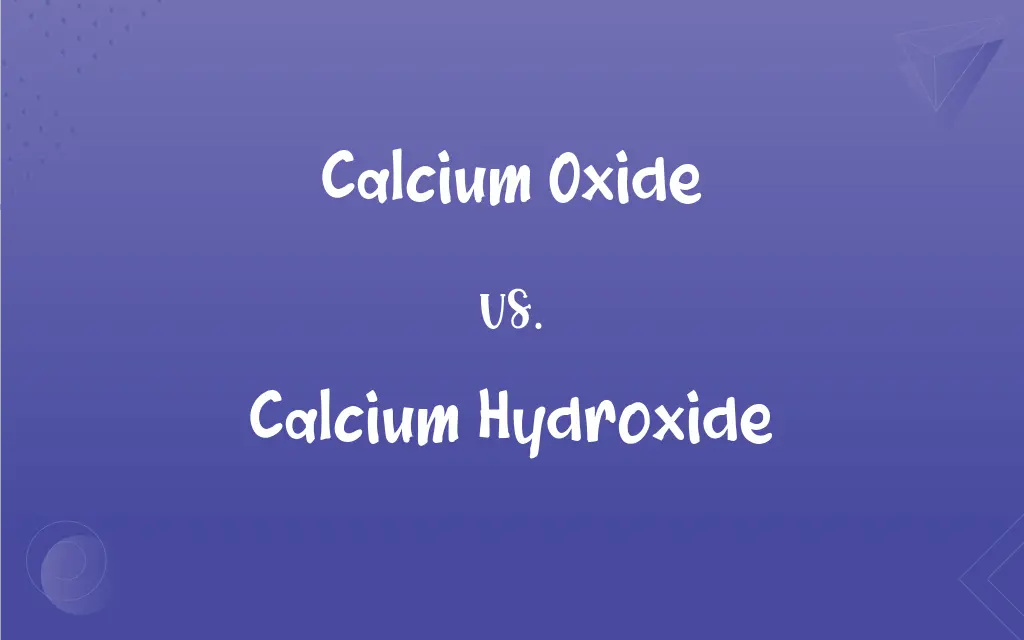Calcium Oxide vs. Calcium Hydroxide: What's the Difference?
Edited by Aimie Carlson || By Harlon Moss || Published on January 7, 2024
Calcium oxide (CaO), also known as quicklime, is a white, caustic, alkaline substance. Calcium hydroxide (Ca(OH)₂), also known as slaked lime, is formed by adding water to calcium oxide.

Key Differences
Calcium oxide is produced by heating limestone (calcium carbonate) in a kiln. Calcium hydroxide is created when calcium oxide reacts with water.
In terms of appearance, calcium oxide is a white to grayish powder. Calcium hydroxide is also a white powder, but it is more crystalline and less caustic.
Calcium oxide is widely used in the construction industry, particularly in cement making. Calcium hydroxide has diverse applications, including in water treatment and as a pH modifier.
The chemical nature of calcium oxide makes it highly reactive with water, releasing significant heat. In contrast, calcium hydroxide is relatively stable and less reactive.
Calcium oxide can be hazardous due to its strong alkalinity and corrosiveness. Calcium hydroxide, while still caustic, is generally safer to handle.
ADVERTISEMENT
Comparison Chart
Common Name
Quicklime
Slaked Lime
Formation
Heating calcium carbonate
Adding water to calcium oxide
Appearance
White to grayish powder
White, crystalline powder
Uses
In cement and construction
Water treatment, pH modification
Reactivity
Highly reactive with water
Less reactive, more stable
ADVERTISEMENT
Calcium Oxide and Calcium Hydroxide Definitions
Calcium Oxide
Reacts vigorously with water.
Adding water to calcium oxide creates heat and light.
Calcium Hydroxide
Used in water treatment processes.
Calcium hydroxide adjusts the pH of water.
Calcium Oxide
A key ingredient in construction materials.
Calcium oxide is integral to manufacturing bricks.
Calcium Hydroxide
Applied in food and agriculture.
Calcium hydroxide is used in corn processing for tortillas.
Calcium Oxide
Produced by heating limestone.
The kiln processed limestone into calcium oxide.
Calcium Hydroxide
Formed by adding water to calcium oxide.
Slaked lime is another name for calcium hydroxide.
Calcium Oxide
Used in environmental applications.
Calcium oxide is utilized to treat acidic soil.
Calcium Hydroxide
A component in some dental materials.
Calcium hydroxide is used in root canal treatments.
Calcium Oxide
A white, alkaline, caustic substance.
Calcium oxide is used to make cement.
Calcium Hydroxide
Less reactive than calcium oxide.
Calcium hydroxide is safer to handle than quicklime.
FAQs
Is calcium oxide hazardous?
Yes, it's caustic and can cause burns.
Does calcium oxide react with water?
Yes, it reacts vigorously.
What is the primary use of calcium oxide?
In cement and construction materials.
How is calcium hydroxide formed?
By adding water to calcium oxide.
Can calcium oxide be found naturally?
Rarely, it's mostly produced industrially.
How is calcium oxide made?
By heating limestone (calcium carbonate).
What is calcium hydroxide used for?
In water treatment and as a pH modifier.
Can calcium oxide purify water?
Indirectly, it's used to make calcium hydroxide for water treatment.
Can calcium hydroxide be used in food?
Yes, in processes like corn nixtamalization.
Does calcium hydroxide have agricultural uses?
Yes, in soil treatment and pH control.
How is calcium oxide stored?
In airtight containers to prevent reaction with moisture.
Is calcium hydroxide less caustic than calcium oxide?
Yes, it's safer to handle.
Is calcium oxide soluble in water?
No, it reacts to form calcium hydroxide.
Is calcium hydroxide environmentally friendly?
Generally, but excessive use can alter soil and water pH.
Can calcium hydroxide be used in construction?
Yes, in mortars and plasters.
What precautions are needed for handling calcium oxide?
Protective gear due to its corrosive nature.
Is calcium hydroxide a strong base?
Yes, it's a moderately strong base.
Is calcium hydroxide safe for dental use?
Yes, in specific dental treatments.
Are there health risks with calcium hydroxide?
It can be irritating to skin and eyes.
Can calcium oxide be used in food?
Not directly; it's too caustic.
About Author
Written by
Harlon MossHarlon is a seasoned quality moderator and accomplished content writer for Difference Wiki. An alumnus of the prestigious University of California, he earned his degree in Computer Science. Leveraging his academic background, Harlon brings a meticulous and informed perspective to his work, ensuring content accuracy and excellence.
Edited by
Aimie CarlsonAimie Carlson, holding a master's degree in English literature, is a fervent English language enthusiast. She lends her writing talents to Difference Wiki, a prominent website that specializes in comparisons, offering readers insightful analyses that both captivate and inform.






































































